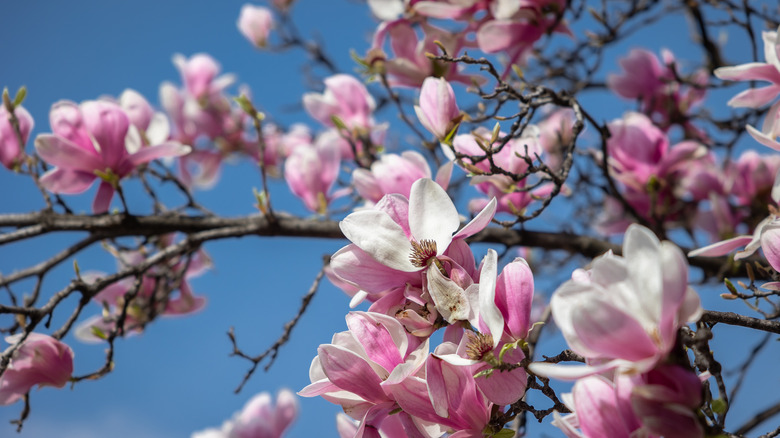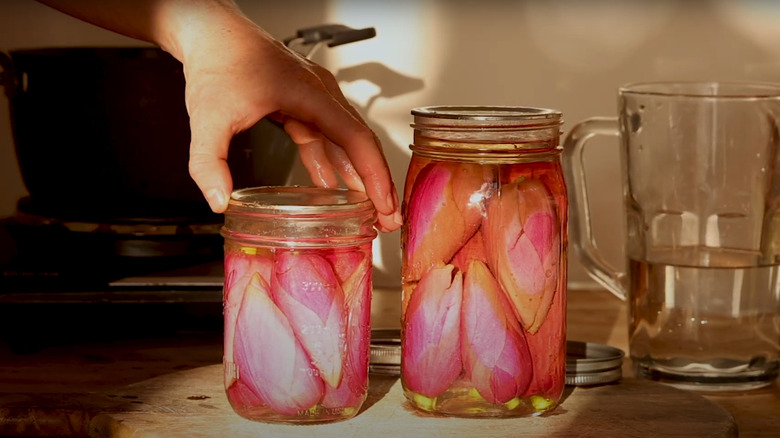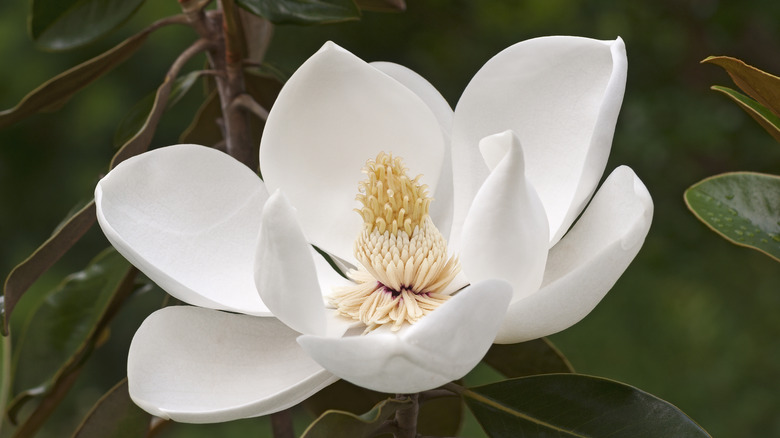What Magnolia Blossoms Taste Like (And How To Prepare Them)
If your For You Page is overwhelmed with videos of foragers chomping on bright pink tree blossoms, don't be alarmed — it's not a bit, it's not harmful, and it could be your key to a great new ingredient for you to explore. Magnolia trees, which typically bloom in early spring, produce a riot of pink and white flowers, which give off an incredible perfume, making them one of the earliest warm-weather harbingers. But these flowers are actually edible — and quite delicious.
Magnolia blossoms have a flavor somewhat like ginger, with notes of clove and cardamom, and a lingering aftertaste. The particular flavor will vary according to the specific type of magnolia, but across the board, they tend to blend both spicy and floral flavors, reminiscent of baking spices.
There are dozens of ways to eat magnolia blossoms, as their complex flavors can work well in a variety of dishes. They can be eaten raw, pickled, dried and powdered, or turned into a simple syrup, sauce, or tea. So think about your favorite uses for ginger, and consider substituting magnolia blossoms for a clever swap.
Cooking with magnolia blossoms
One of the most common ways to prepare magnolia blossoms is to pickle them and serve them as you would serve pickled ginger, as an accompaniment to sushi or rice bowls. You can pickle the blossoms whole, or take the petals apart and pickle them separately. Rice vinegar is a common pickling base, but feel free to experiment.
Fresh magnolia blossoms can be used as lettuce wraps (think, sweet-spicy larb and white rice) or as a second wrapping layer in a sushi handroll. They also make a lovely addition to salads (either pickled or fresh), if you're looking to impress guests with a beautiful springtime dish. You can make a simple syrup out of magnolia blossoms to use in cocktails (perhaps with gin and some citrus juice), or to spike seltzer to create a fresh take on homemade ginger ale. Or you could use this syrup to make knockoff gingersnaps.
@alexisnikole FLOWER COOKIES 🍪🌸 #LearnOnTikTok #TikTokPartner #wildfood
Magnolia blossoms can also be dehydrated and used in lieu of ginger for a warm spiced ginger tea, or as a stand-in for chai. The dried blossoms can also be powdered and used as a dried ginger substitute, which can be used in all manner of baked goods, like these ginger cranberry cookies. Battered and fried magnolia blossoms are also quite a treat, something like a spicier take on beignets de fleurs de courgettes. Or perhaps you'd prefer to candy your magnolia petals to make a sweet garnish for treats or drinks.
Tips for harvesting magnolia blossoms
Magnolia trees are easy to identify by their abundance of pink or white blossoms, which are large and either tulip-shaped or star-shaped, depending on the variety. When harvesting magnolia blossoms, you'll want to pay attention to their color, which is generally indicative of their flavor. White magnolia petals have a far more delicate flavor while dark pink blossoms tend to be more intense or even bitter.
The best magnolia blossoms to harvest are the ones that fall in between. Look for blossoms with a white interior of petals and a pinker outer layer, or flowers that are pale pink in their entirety. These will have the best balance of flavors to use in cooking.
Dried petals will retain less flavor, however, so if you plan on drying your magnolia blossoms you may wish to use darker, more flavorful petals. Either way, you've found yourself a sweet treat with a myriad of uses, just in time for spring cooking. Just make sure you're positive that what you have is a magnolia, and be sure to wash the flowers gently before you prepare them.



